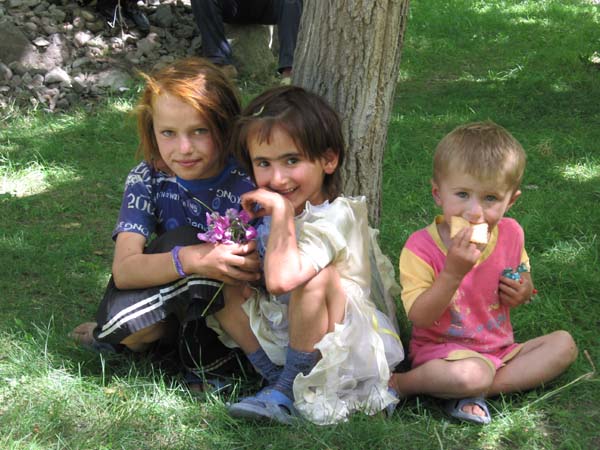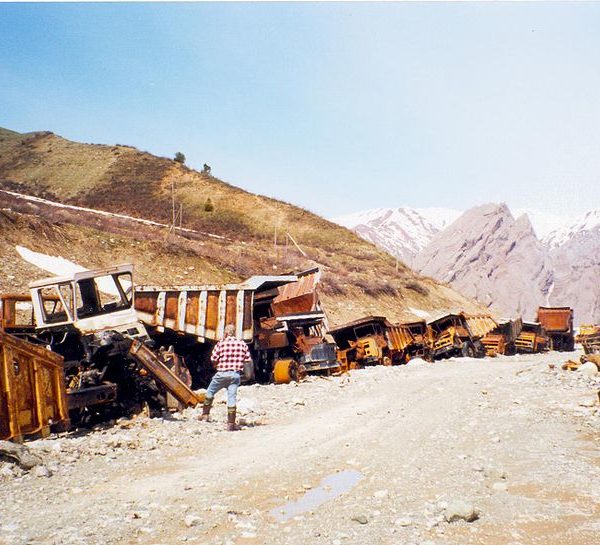An indigenous language conflict exists in Tajikistan between the dominant Tajik ethnicity and the minority Pamiri population. A loose association of several dozen languages, the term ‘Pamiri’ describes these related dialects from the Iranian language family and the ethnicities that speak them. Isolated in Tajikistan’s autonomous Gorno-Badakhshan region, the Pamiris did not develop a written form of their language until the 1920s and remained undisturbed until their assimilation into the Soviet Union in 1929 [Ilolov, M., Ilolova, P., & Yusufbekov, S., 2015]. A Pamiri push for independence during the late 1980s led to a separatist movement that plunged the country into a bloody civil war in 1992. As a result, Pamiris were targeted by the Tajik government and, although peace accords were signed in 1997, tensions remain between the Pamiri minority and Tajik majority [Sobiri, 2017]. Today, the Tajik government does not recognize the Pamiri ethnicity or language, complicating the Pamiris’ ability to use their language in schools, government, and legal affairs.
Historical Background
Inhabiting Tajikistan’s mountainous Gorno-Badakhshan region for centuries, the Pamiri had limited contact with the outside world until the late nineteenth century [Kolga, 2001]. They remained largely undisturbed until the 1920s when the Soviet Union surveyed ethnic minorities on the fringes of its territory [Kolga, 2001]. After World War II, the Soviet government ordered the resettlement of 40-70% of Pamiris living in villages deemed too isolated or lacking in arable land for continued habitation [Kolga, 2001]. Resettlement efforts peaked between 1951-54, with Pamiris deported against their will to farms at lower altitudes. By the 1960s, the Soviet government had transitioned towards single-crop agriculture while discouraging the production of traditional Pamir crafts and crops [Kolga, 2001]. These agricultural policies were ultimately unsuccessful, leaving Gorno-Badakhshan one of the poorest regions in Tajikistan [Minority Rights Group International, 2018]. Additional complications arose as Pamiri languages were not written and were kept out of schools in favor of Russian or Tajik, disenfranchising Pamiri people [Kolga, 2001].
By the 1980s, these policies resulted in a separatist push for Gorno-Badakhshan’s independence [Minority Rights Group International, 2018]. Resentment grew in 1989 with the introduction of a law that would make Tajik the only official language of Tajikistan by 1996, preventing Pamiris from speaking Pamiri in business, government, and education [Open Society Institute, n.d.]. In 1991, a Pamiri political party called Lali Badakhshan rose to prominence in Gorno-Badakhshan as anti-government protests broke out, calling for independence in 1992 [Minority Rights Group International, 2018]. This sparked a bloody civil war between the new Tajik government and the United Tajik Opposition from 1992 to 1997. Pamiris were targeted by the Tajik government as supporters of insurgents, and while a 1993 peace accord gave Gorno-Badakhshan relative autonomy, economic blockades weakened the province while the war continued for four more years [Minority Rights Group International, 2018].
After the war’s conclusion, Pamiris faced discrimination and limited language rights outside Gorno-Badakhshan [Minority Rights Group International, 2018]. In 2012 and 2015, Gorno-Badakhshan saw outbreaks of violence and protests between the Tajik government and Pamiri opposition forces, while the presence of former opposition leaders furthered tensions between Pamiris and Tajiks [Mostowlansky, 2019]. Most recently, the Tajik government has refused to recognize Pamiris as having a distinct language or ethnic identity and associated Pamiri militias with Islamist fighters in efforts to crack down on terrorism, furthering Pamiri resentment [Mostowlansky, 2019]. Additional complaints about Tajiks discriminating against Pamiris continue into the present, with Pamiris claiming they are second-class citizens within their own country [Minority Rights Group International, 2018].
The Rise of Russian Language Schools
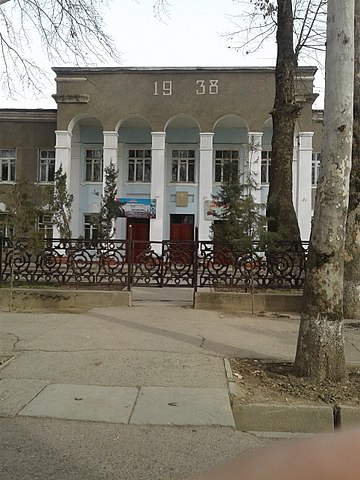
In January 2020, Tajikistan’s parliament agreed to continue building five new schools providing instruction in Russian, a proposition funded by the Russian government and reflecting close ties between the two countries. These schools will provide education for upwards of 6000 students. Under the Soviet regime, Russian language instruction was common at all educational levels, a practice that decreased after the 1992 collapse of the Soviet Union, granting Tajikistan its independence. Much of Tajikistan’s remaining ethnic Russian population fled the country during the 1992-97 civil war. Schools began teaching primarily in Tajik, with limited accommodations made depending on the region and requirements of pupils. Despite the lack of an ethnic Russian population and state promotion of Tajik as an official language, the demand for Russian-language schools has increased in recent years. Approximately one-third of Tajikistan’s economy is directly from remittances from Tajik migrant workers in other countries, namely Russia and Uzbekistan, and Russia remains a popular destination for institutions of higher education. Parents believe providing their children with Russian language skills will improve their employment prospects and that Russian schools provide a better quality of education overall. Tajikistan remains one of the poorest former Soviet states, with a high youth population facing low average wages and high unemployment, statistics even higher among Pamiri populations in Gorno-Badakhshan. Due to this, studying in Russian-language schools is becoming increasingly popular, as the language is seen as a chance for a more prosperous future [Najibullah, 2020].
Pamiri Cooking
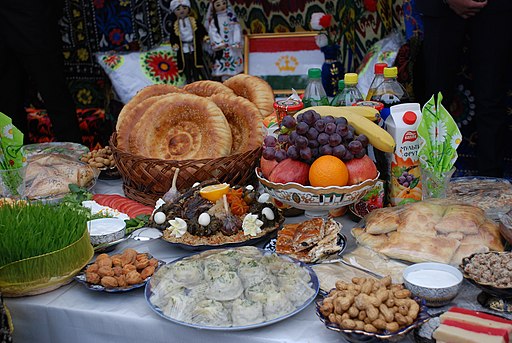
In 2016, Jamila Haider and Frederik van Oudenhoven, a pair of Swedish and Dutch researchers, published With Our Hands, a cookbook featuring a collection of recipes from Pamiri villages in Afghanistan and Tajikistan. The book was published in three languages: English, Afghan Persian or Dari written in the Arabic script, and Tajik Persian written in the Cyrillic alphabet. The result is a book that accommodates readers from different languages and cultures while exposing them to Pamiri traditional foods, holidays, and cultural traditions that otherwise would remain largely constrained to the Pamir Mountains and their inhabitants. In an interview, Haider recounts an experience working in Tajikistan where a Pamiri grandmother asked her to write down traditional recipes that she was concerned her children would forget as her language - like most of the Pamir languages - does not have a written form. As a result, Haider and a group of female scientists from educational institutions in Gordo-Badakhshan began collecting recipes in the region that previously only been passed down orally. The resulting book ties in traditional foods from the Pamir Mountains with holidays, religious observances, and cultural practices while preserving Pamiri culture for future generations and external audiences [Oudenhoven, 2016].
Female Entrepreneur of the Year
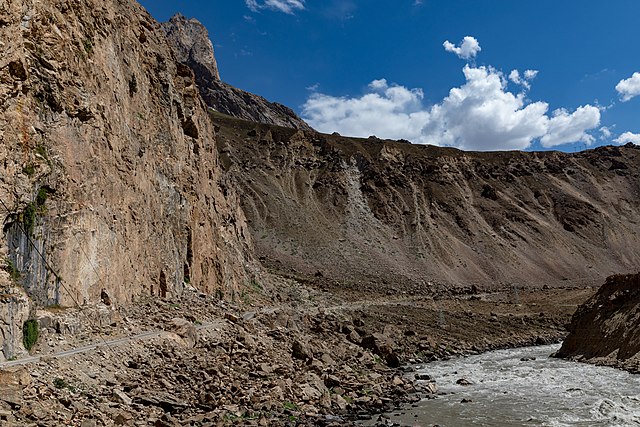
A 2012 Eurasianet article tracks the progress of Tajik and Pamiri women attempting to grow their own businesses in a sociopolitical climate that promotes women remaining at home and discourages foreign investment. In 2012, an event called Farah [‘brilliance’ in Tajik] was set up to name the country’s “first female entrepreneur of the year” [Eurasianet, 2012]. Nabot Gomadina is a Pamiri businesswoman who described the difficulties of running a profitable business in Gorno-Badakhshan, where isolated towns, poor roads blocked by snow for months at a time, and a largely impoverished population complicate business activity. Gomadina became the founder of the first micro-loan business in Gorno-Badakhshan and has since began operating workshops helping other women with their finances. Her role is unusual in a country where men make up most of the workforce, often working outside Tajikistan and sending remittances to their wives and families at home. The work of Gomadina and women like her represents a step towards greater gender equality in Tajikistan, as well as a chance for Pamiri communities to improve their economic status [Eurasianet, 2016]. Pamiri families tend to emphasize the role of education for their children, especially girls, who enjoy more freedom and less pressure to marry than Tajik girls their same age. This has a mixed effect: on the one hand, it makes it easier to identify and discriminate against Pamiris; however, Pamiri women benefit from greater social freedoms in a nation that is largely male dominated [Anti-Discrimination Centre, 2017].
Compare Language Similarities
Linguistic Background
- Genealogy/relatedness: Tajik, also called Tajik Persian, is an Indo-European language and a member of the West Iranian branch of the Iranian language family [Center for Languages, Indiana University Bloomington, n.d.]. Its closest relation is Dari, the Persian language spoken primarily in Afghanistan, followed by Farsi, the Persian language spoken primarily in Iran. The three languages are all mutually intelligible to a degree and have been collectively described as various dialects of Persian [UCLA Language Materials Project, n.d.]. To a lesser degree, Tajik is related to more distant West Iranian and Persian languages and additional East Iranian languages including Yaghnobi and Pashto. Tajik has two dialects, northwestern and southwestern, with northwestern being the dominant dialect [UCLA Language Materials Project, n.d.]. The Pamiri language is more accurately described as a group of related languages spoken in Tajikistan’s Gorno-Badakhshan province, Pakistan, Afghanistan, and Western China by communities living in the Pamir Mountains. These languages are, like Tajik, Indo-European members of the Iranian language family, although they are members of the East Iranian languages and not mutually intelligible with Tajik [Kalandarov, 2020]. Generally, the Pamiri languages include Shughni-Yazgulami branch with Shughni, Sarikoli, and Yazgulyam languages and dialects of Roshani, Bartangi, Oroshori, Shughni, and Khufi; Munji and Yidgha languages; Sanglechi, and Ishkashimi languages; and the Wakhi language [Kolga, 2001]. Both Tajik and Pamiri languages are rooted in Old Iranian, although Tajik has more Turkish influences and Russian loanwords while Pamiri languages preserved more Old Iranian structure due to their relative isolation [Indiana University Bloomington, n.d.].
- Phonology/phonetics: Most Pamiri languages do not have sufficient speakers or records of their language to describe their phonologies, morphologies, lexicon/vocabularies, and orthographies [Kalandarov, 2020]. Shughni, which developed a written form in the 1930s, is the Pamiri language with the most speakers in Tajikistan and the most academic literature. Shughni has 10 vowels (with long and short distinction) and 27 consonants [Edelman, 1999]. It is more complex than Tajik which has six vowels and 24 consonants [Nasrullo & Thompson, 2009]. Shughni and other Pamiri languages have more in common with Old Iranian languages due to their geographic isolation [Omniglot, n.d.]. Shughni has many borrowings from Tajik, Arabic and Russian [Edelman, 1999]. Tajik is also influenced significantly by Russian. One difference between Tajik and Shughni is that in some loanwords, Tajik makes use of Russian sounds such as /ɕː/ represented by a letter ‘щ’ that are absent in Shughni and other Pamiri languages [Omniglot, n.d.].
- Morphology and grammar: Tajik and Shughni follow subject-object-verb (SOV) word order [Edelman, 1999]. Tajik affixes endings to nouns to distinguish by possession and number but does not separate individual nouns as masculine or feminine [Perry, 2005]. Shughni, however, distinguishes between grammatical gender [Edelman, 1999]. Tajik inflections typically are on the last syllable of a word’s root. Tajik verbs are distinguished as singular or plural, as first, second, or third person; in either past, present, or inferential past tenses; in indicative, subjunctive, or counterfactual conditional moods; in imperfective and perfective tenses, and when referring to the future, using a modality rather than a tense. Tajik uses personal pronouns in either singular or plural first, second, or third person and enclitic forms to indicate possession [Perry, 2005].
- Lexicon and vocabulary: There is relatively little overlap between these two groups. Both are Iranian languages, but Tajik is a West Iranian language while the Pamiri languages are East Iranian languages [UCLA Language Materials Project, n.d.]. The two languages did not interact much historically, and while Tajik has overlap with Russian, Uzbek, Dari Persian, Farsi Persian, and some Turkic languages, the isolated nature of the Pamir Mountains meant Pamiri languages were not overly influenced by or influencing Tajik [Indiana University Bloomington, n.d.].
- Orthography/writing system: Most Pamiri languages do not have a writing system. Some dialects were transliterated into the Cyrillic alphabet and written down according to the Tajik language sounds and rules during the 1920s and 1930s, but these systems are not widely in use and only fragments of most Pamiri languages have been published or listed online [Kolga, 2001]. Shughni is the Pamiri language with the most prominent written language system, having been written in the Arabic script up to 1931, the Latin alphabet from 1931-1938, and the Cyrillic alphabet from 1938 to the present. However, there are insufficient speakers for it to compete with Tajik [Omniglot, n.d.]. Like Shughni, Tajik was written in the Arabic script until 1928, when the Latin alphabet was introduced, only to be replaced by the Cyrillic alphabet in 1940. The Cyrillic alphabet was popularized during the Soviet Union and taught in schools, a practice common in Central Asian states under Soviet control [UCLA Language Materials Project, n.d.]. The Cyrillic alphabet is still used for Tajik in Tajikistan today.
- Discourse/sociolinguistic factors/influences on development/history: Due to the proliferation of Russian language under the Soviet Union, Tajik has been influenced by Russian [Omniglot, n.d.]. Tajik is the official language of Tajikistan, is spoken by the majority of the population, and is used in much of the country although Russian is permitted for use in internal affairs. In contrast, the diversity of Pamiri languages, their geographic isolation, and the relatively small percentage of speakers in Tajikistan has resulted in Pamiris being underrepresented in governmental issues and public life as well as discriminated against socially [Anti-Discrimination Centre, 2017].
Resources
Al Jazeera. (2012, July 25). Deadly fighting erupts in Tajikistan. Retrieved October 24, 2020, from https://www.aljazeera.com/news/2012/7/25/deadly-fighting-erupts-in-tajikistan.
Anti-Discrimination Centre. (2017, July). Alternative Report on Tajikistan's Implementation of the International Convention on the Elimination of All Forms of Racial Discrimination.
Retrieved September 06, 2020, from https://www.ecoi.net/en/file/local/1404047/1930_1500468708_int-cerd-ngo-tjk-28052-e.pdf.
BBC. (2012, July 24). Tajikistan clashes: 'Many dead' in Gorno-Badakhshan. Retrieved October 24, 2020, from https://www.bbc.com/news/world-asia-18965366.
Borisov, A. (2015, August 28). Tajikistan's Islamic opposition party faces ban amid crackdown. Retrieved October 24, 2020, from https://news.yahoo.com/tajikistans-islamic-opposition-party-faces-ban-amid-crackdown-183932617.html?guccounter=1.
Center for Languages, Indiana University Bloomington. (n.d.). Tajiki. Retrieved October 24, 2020, from https://celcar.indiana.edu/materials/language-portal/tajiki/index.html.
CIA. (2020). Country Comparison: Distribution of Family Income - Gini Index. Retrieved October 22, 2020, from https://www.cia.gov/the-world-factbook/field/gini-index-coefficient-distribution-of-family-income/country-comparison.
CIA. (2018, February 01). The World Factbook: Tajikistan. Retrieved October 22, 2020, from https://www.cia.gov/the-world-factbook/countries/tajikistan/.
Data Commons. (2020). Tajikistan. Retrieved October 22, 2020, from https://datacommons.org/place/country/TJK.
Dodikhudoeva, L. (2004). The Tajik Language and the Socio-Linguistic Situation in the
Mountainous Badakhshan. Iran & the Caucasus, vol. 8, no. 2. 281-288. Retrieved
October 22, 2020 from https://www.jstor.org/stable/4030996.
Edelman, Joy Iosifovna. (1999). Иранские языки. III. Восточноиранские языки [Languages of the World: Iranian Languages. III. Eastern Iranian languages] / N. Rogova – M. Indrik Publlishers. - p. 225-241.
Eurasianet. (2012, August 7). Tajikistan: Women Strive to Carve Out Economic Niche.
Retrieved October 25, 2020, from https://eurasianet.org/tajikistan-women-strive-to-carve-out-economic-niche.
Everyculture. (n.d.). Pamiri. Retrieved October 23, 2020, from https://www.everyculture.com/wc/Tajikistan-to-Zimbabwe/Pamiri.html.
The Fund for Peace. (2020). Fragile States Index. Retrieved October 22, 2020, from https://fragilestatesindex.org.
Ilolov, M., Ilolova, P., & Yusufbekov, S. (2015). Pamiri Languages and Problems of Written Language (Vol. 1). Tajikistan: Academy of Sciences of the Republic of Tajikistan.
Retrieved October 20, 2020 from https://concall.indiana.edu/2014/proceedings/Ilolov.pdf.
Institute for War and Peace Reporting, (2009, October 3). Concern Over New Tajik Language Law, RCA No. 590. Retrieved September 15, 2020, from https://www.refworld.org/docid/4acaea9826.html.
Index Mundi.(2015). Tajikistan - GINI index (World Bank Estimate). Retrieved October 22, 2020, from https://www.indexmundi.com/facts/tajikistan/indicator/SI.POV.GINI.
Kalandarov, T. (2020). The Pamirian languages: between past and future
(the case of the Shughni language). Cultural Heritage and Humanities Unit of UCA, Research Paper # 5, p. 32.
Kolga, M. (2001). The Red book of the Peoples of the Russian Empire. Tallinn: NGO Red Book.
Lozovsky, I. (2018, June 5). The Death of Tajikistan's Islamic Renaissance. Retrieved October 24, 2020, from https://www.occrp.org/en/moneybymarriage/the-death-of-tajikistans-
Ministry for Foreign Affairs of Finland. (2017). Country Strategy for Development Cooperation: The Kyrgyz Republic and Tajikistan 2018-2021. Retrieved October 22, 2020 from
Minorities at Risk Project, Chronology for Uzbeks in Tajikistan, 2004. Rereviewed October 23, 2020, from https://www.refworld.org/docid/469f38e6c.html.
Minority Rights Group International. (2018, April 03). Pamiris. Retrieved October 23, 2020, from https://minorityrights.org/minorities/pamiris/.
Mostowlansky, T. (2019, February 28). Tajikistan's Troubled Pamir Region. Retrieved October 23, 2020, from https://thediplomat.com/2019/02/tajikistans-troubled-pamir-region/.
Najibullah, F. (2020, January 20). No Shortage of Students as Tajikistan Builds New Russian Schools. Retrieved October 25, 2020, from https://www.rferl.org/a/tajikistan-new-russian-schools/30384557.html
Nasrullo, K., & Thompson, M. (2009). Tajiki Reference Grammar for Beginners.
Washington, DC: Georgetown UP.
Numeral Systems of the World’s Languages. (n.d.). Ishkashmi. Retrieved October 23, 2020, from https://mpi-lingweb.shh.mpg.de/numeral/Ishkashmi.htm.
Omniglot. (n.d.). Shughni (Хугьнуон зив / Xuġnůni ziv). Retrieved October 24, 2020, from https://omniglot.com/writing/shughni.htm.
Omniglot. (n.d.). Tajik (тоҷики). Retrieved October 24, 2020, from https://omniglot.com/writing/tajik.htm.
Open Society Institute. (n.d.). Language and Ethnicity Issues in Tajikistan. Retrieved October 23, 2020, from http://ismaili.net/mirrors/112_tajik/tajkethn.html.
Oudenhoven, F. (2016, July 27). A cookbook sheds light on the little-known Pamiri culture. Retrieved October 25, 2020, from https://scroll.in/article/812203/telling-stories-through-
food-a-pamiri-cookbook-sheds-light-on-a-little-known-culture.
Perry, J. R. (2005). A Tajik Persian Reference Grammar (Boston: Brill).
Peyrouse, S. (2012). Battle on Top of the World: Rising Tensions in Tajikistan’s Pamir Region. The German Marshall Fund of the United States, 1-4. Retrieved June 3, 2021, from https://www.gmfus.org/publications/battle-top-world-rising-tensions-tajikistan%E2%80%99s-pamir-region.
Shugni Language. (2020, October 22). Retrieved October 24, 2020, from
https://en.wikipedia.org/wiki/Shughni_language.
Sobiri, B. (2017, June 23). The long echo of Tajikistan's civil war. Retrieved October 24, 2020, from https://www.opendemocracy.net/en/odr/long-echo-of-tajikistan-s-civil-war/.
Tajik grammar. (2020, October 05). Retrieved October 24, 2020, from https://en.wikipedia.org/wiki/Tajik_grammar.
Tunçer-Kilavuz, I. (2011). Understanding Civil War: A Comparison of Tajikistan and
Uzbekistan. Europe-Asia Studies, 63(2), 263-290. Retrieved October 24, 2020, from https://login.pallas2.tcl.sc.edu/login?url=http://search.ebscohost.com/login.aspx?direct=true&db=aph&AN=59330028&site=ehost-live.
UCLA Language Materials Project. (n.d.). Tajik. Retrieved October 24, 2020, from
http://www.parstimes.com/language/tajik/.
United Nations Human Development Report. (2019). Inequalities in Human Development in the
21st Century: Tajkistan. Retrieved October 22, 2020, from http://hdr.undp.org/sites/all/
themes/hdr_theme/country-notes/TJK.pdf.
University of Massachusetts. (2007). Shugni Language Page. Retrieved October 24, 2020, from http://people.umass.edu/ellenw/Shughni%20language%20page.htm.
Images:
Geoalex. (1931). Shugni Alphabet 1931 [Digital image]. Retrieved October 24, 2020, from https://commons.wikimedia.org/wiki/File:Shugni_alphabet-1931.JPG.
Harrington Spier, B. (1997). BelAZ dump trucks burned during the Civil War in Tajikistan [Digital image]. Retrieved October 24, 2020, from https://en.wikipedia.org/wiki/File:BelAZ_dump_trucks_burned_during_the_Civil_War_in_Tajikistan.jpg.
Math920Me. (2003, June 5). Tajik Pamiri Children [Digital image]. Retrieved October 24, 2020, from https://commons.wikimedia.org/wiki/File:Tajik_Pamiri_children.jpg.
McDonald, J. (2012, August 4). 2012 Khorog Barricade on M41 Highway in Tajikistan [Digital image]. Retrieved October 24, 2020, from https://commons.wikimedia.org/wiki/File:2012_Khorog_Barricade_on_M41_Highway_in_Tajikistan.png.
MrPenguin20. (2014, July 7). Flag of the Islamic Renaissance Party of Tajikistan [Digital image]. Retrieved October 24, 2020, from https://commons.wikimedia.org/wiki/File:Flag_of_the_Islamic_Renaissance_Party_of_Tajikistan.svg.
Ninara. (2018, July 9). Gorno-Badakhshan, Tajikistan [Mountainous roads usable only half of the year]. Retrieved October 24, 2020, from https://commons.wikimedia.org/wiki/
File:Gorno-Badakhshan,_Tajikistan_(43300148104).jpg
Saadiev, S. (2018, February 11). School in Dushanbe [Digital image]. Retrieved October 24, 2020, from https://commons.wikimedia.org/wiki/File:School_in_Dushanbe.jpg.
Credits
Posted: 19 June 2021
Previous versions:
Contributing Analysts: Jill Boggs
Editors: Gareth Rees-White, Elena Galkina

